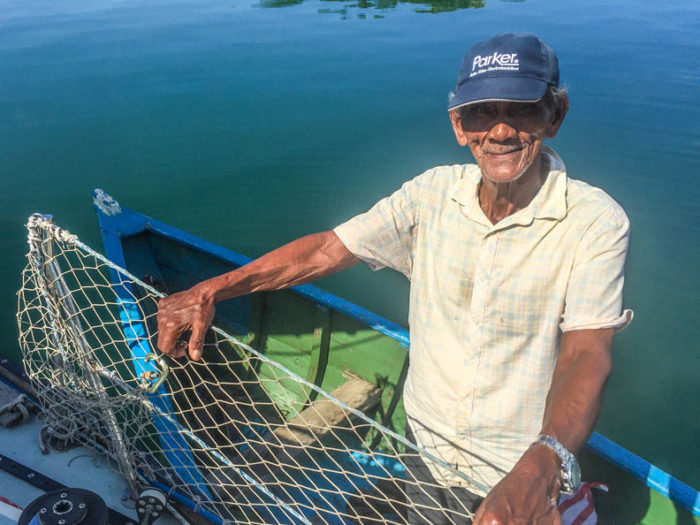“Panama is NOT a developing country.” The young sailor leans back in her chair in the tranquil courtyard of the marina. “They’ve got all the money from the canal. People are doing alright here.”
A root-choked path filled often with thigh-high mud leads from our spot in the marina to an indigenous village less than half a kilometer away. In this village, Bahía Roja, I have seen deeper poverty than anywhere else we have visited on our sail. And it’s all within a 10-minute walk from villas that rent for $967 per night. So what’s going on here?
The canal anchors Panama’s international image. Enormous container ships, longer than 4 football fields and stacked up to 24 stories high, steam implacably through this path between the oceans, churning $270 billion in international commerce every year through the continent (Panama makes about one percent of that for transit fees.) The canal is the largest tourism draw in the country.
Oleada exiting the Miraflores locks, Panama Canal, as shown from one of the canal webcams.
International money hums at both ends of the cut. One of the world’s largest duty free zone lures international companies at Colón, on the Caribbean entrance. On the Pacific side, dazzling steel and mirror skyscrapers lit in neon and LED screens are stacked on the edge of the sea in the capital, Panama City. In Spanish, this city goes just by the name, ‘Panamá;’ in other words, this city is Panama, as the usage implies. Amid this commerce, the GDP of Panama has grown twice as fast as the rest of its Latin American neighbors in the past 15 years.
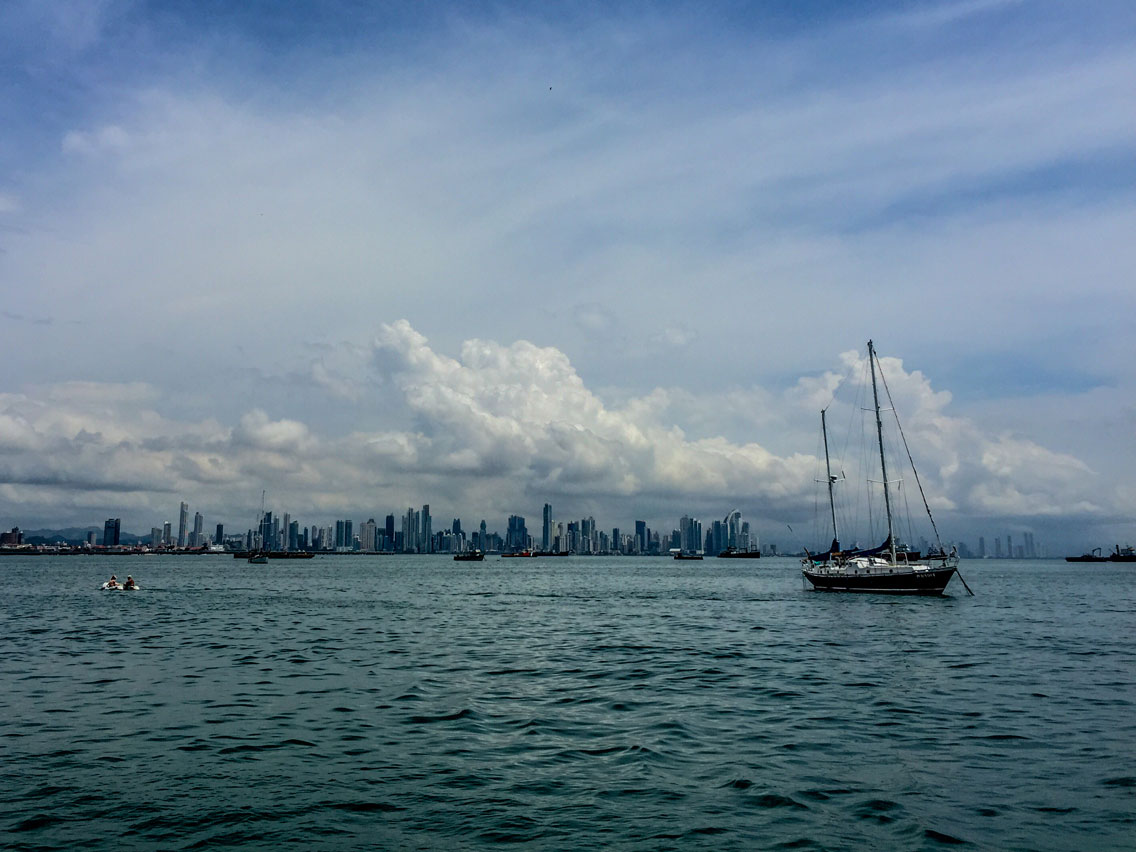
However, Panama hides a secret behind this economic boom; it is the second most unequal country in the Americas, after Brazil. Latin America leads the world in wealth and income inequality—so that translates to severe disparity. Despite a World Bank report last year showing improvements in the inequality gap, the CIA notes that, “strong economic performance has not translated into broadly shared prosperity.”
There is little trickle down from the canal to the coast—a coast that displays inequality in shocking fashion.
Isla Parida
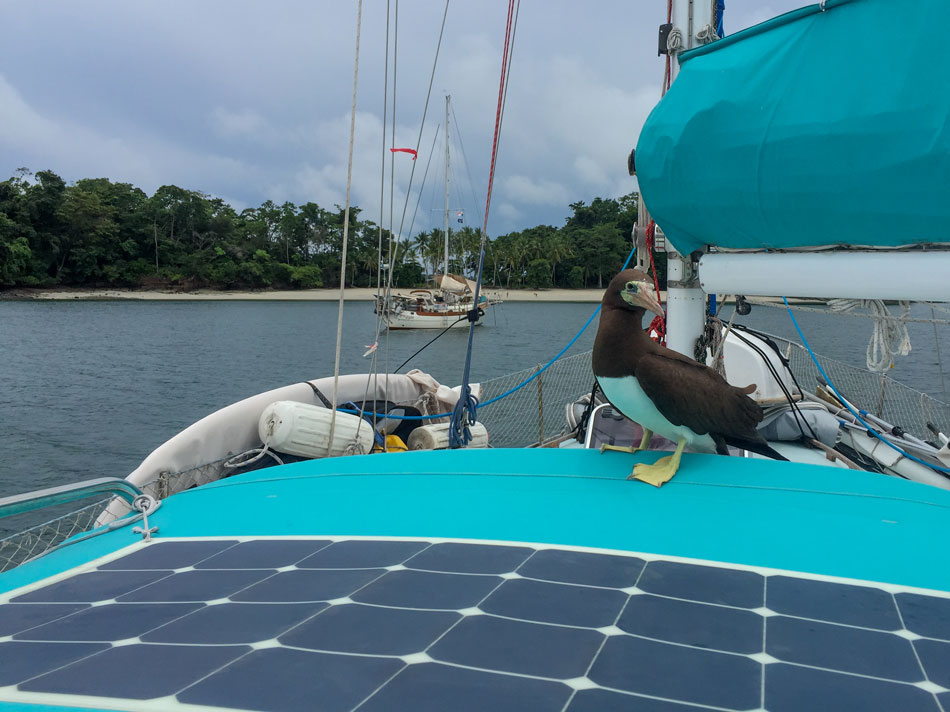
I’m standing in clear, waist-deep water over twenty miles from shore. Oleada rests anchored a few hundred yards away in the protection of Isla Gamez, part of the Chiriquí Marine Park established in 1994 in Pacific Panama. On the wind-touched bay, protected from swell, an unhurried paddler in a yellow sit-on-top kayak glides slowly towards me. He’s wearing a wetsuit a little too large for his slender frame, with black cotton socks tucked into the legs. His boat is overflowing with conch shells, giant colorful clams in deep purples and brilliant reds, and a five-gallon bucket with a net stretched over the top.
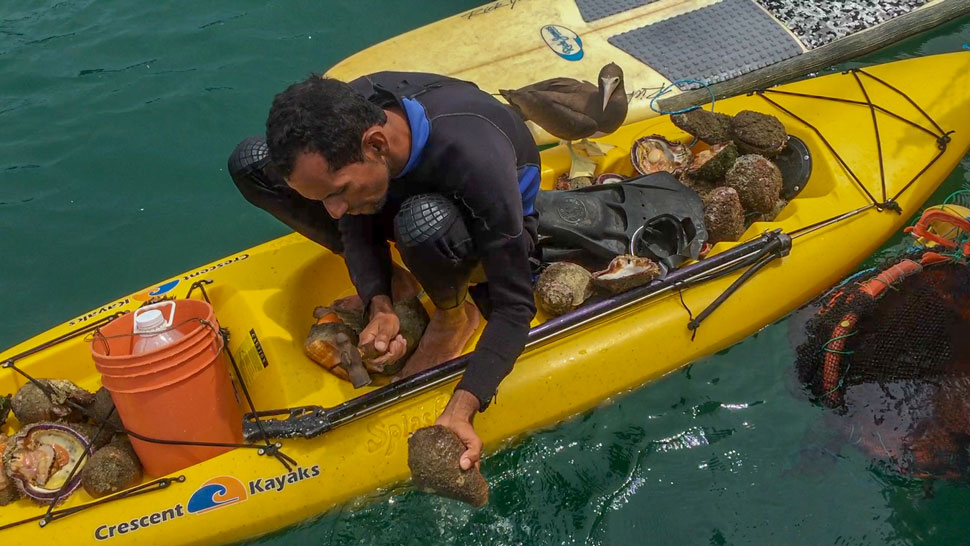
This is Carlos Bernal. He’s the same age as my husband, Josh, and he lives one week on, one week off at adjoining Isla Parida. His father has owned a shack here for fifty years. Far more families used to live on the islands, growing rice and watermelons. But Americans bought most of the property twenty years ago, and the island communities dissolved. His eyes twinkle a little as he tells me that one of the islands is now for sale for two and half million dollars. As we chat, he uses his diving mask, a silver metal oval from the 1970s, to splash water reflexively and tenderly into his bucket of lobsters. He reminds me of other buceadores I have met: contemplative, straightforward, kind, as if the time underwater has showed them a quieter world which they have absorbed through the years.
Everything about Carlos is gentle. He handles his conch, clams, and lobster with long, careful fingers. No movement is quick; he gestures flow like the water keeping the lobsters alive. He even blinks slowly. His dark eyes are set deep in his head; the wrinkles over his young skin give him a wizened look. Instead of referring to the wind as viento, he calls it ‘la brisa’, the breeze. As if calling something by a gentler name makes it so. It feels like his pensive gaze is entwined with the ocean’s unfathomable soul. Suddenly, life on the water feels a little more forgiving.
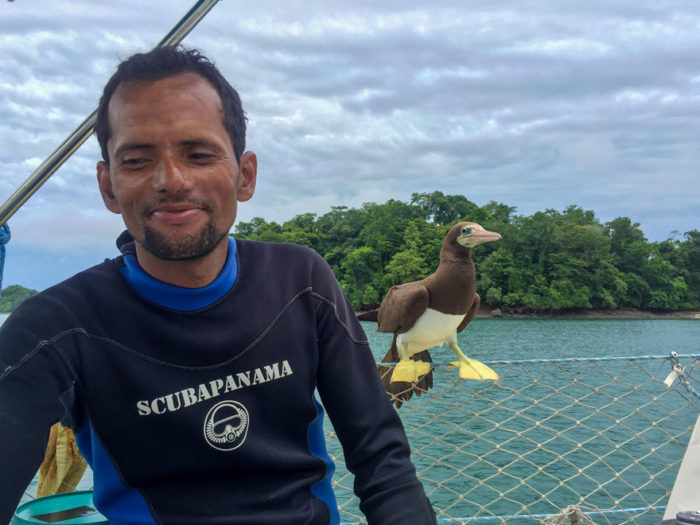
Since he finished primary school, Carlos has been diving for food and work. He never went to high school. When I ask him why he decided to stay here, he doesn’t seem to understand the question— like it’s never crossed his mind to do anything else. The sea runs in his blood: of his six brothers, two are artisanal fishermen, and the other four are divers like him, working out of a sit-on-top kayak, possibly wearing cotton socks.
But he’s still tied to the land. His wife and two kids live in the nearby city of Davíd, on the mainland; he states with pride that his oldest daughter is starting high school.
What’s so striking about Carlos is how simply he lives. The wetsuit is recycled. His mask is a relic of the early days of diving. He’s fishing and diving without a motorized panga, just a plastic kayak. We haven’t seen anyone yet fishing with such a simple boat. He sells us three spiny lobsters for $15.
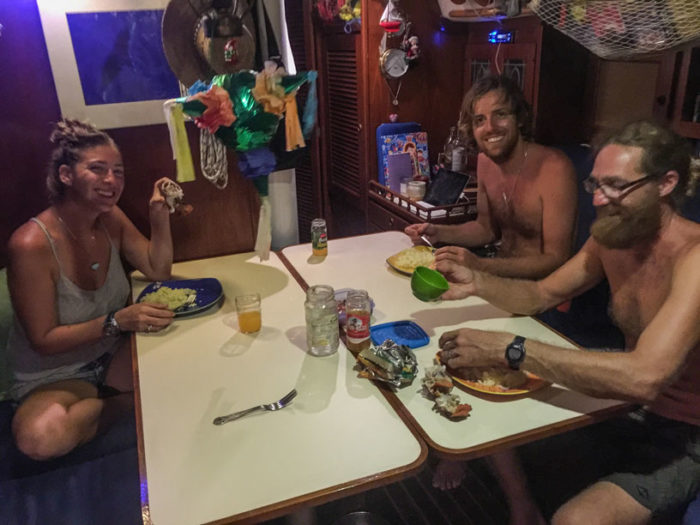
Carlos lives by the natural world and he is aware how much has changed. He says the beaches shrink from more waves and more powerful storms; the tides rise higher; dead corals wash ashore. In Pedregál, the first town tucked into the mangroves on the mainland, this year the high tide for the first time completely covered the parking lot where fishers launch their boats.
Despite the changes in the sea, Carlos’ greatest concern is fresh water on the island. Right now, natural springs provide enough water to drink and cook. However, during the dry season last year, the major spring dried up for the first time. He’s worried this will continue. Even so, he tells us we can use the water to do laundry, knowing that fresh water is a rare commodity on a sailboat.
The Pacific coast of Central America has felt this increasing incremental dryness, punctuated by the searing drought of El Niño, for the last few years in some places, decades in others. Carlos doesn’t spend his days looking at predictive climate models, but they all would confirm his fears: it’s going to get drier. What happens to his entire family’s way of life if he doesn’t have enough to drink and can’t grow his few crops on the island? His only insurance comes from the sea—and like everywhere we have been, he can tell me that the sharks that were here 20 years ago are all gone, and the fish and lobster are dwindling.
Despite his lack of money and fancy diving equipment, Carlos is generous with his time and what he has. The next morning, we watch in delight as he pulls a hulking, rusted refrigerator that washed onto the beach in the night into the slender, rough-hewn panga he drives with a decent outboard. He carves his boat deftly to nose alongside Oleada, and Josh hands him a cup of coffee. He passes us five enormous conch shells; he noticed how enamored I was with them the day before. He also brings us a collection of other shells from the island. He has a lemon grass plant for us that he took out of the ground with the roots; good for tea, he tells us. Just plant it in a mix of sand and dirt. His friendship comes earnestly and without expectation.
How can I return his generosity? I pass him a giant red abalone shell we’ve carried with us from Baja, and I root around in our closet (the bottom of which is a catch-all for boat storage) until I find an unopened bottle of wine and tequila from our wedding. He looks appreciatively at the bottles. Whenever we drink it, I will think of you, he says. I believe him.
As we pull up the anchor, Carlos drives his boat out into the morning breeze. He told us that tourism to the islands started two or three years ago. When the islands became a marine park, visitors from the government and academic institutions arrived to study and clean the islands, and tourism traffic is starting to catch up and enjoy the clean white beaches. He credits the wave of researchers as inspiring him to keep the islands clean–a sentiment we’ve heard before from tourism operator Julio Mata on protected Isla Isabel in Mexico. He hopes, in a couple of years, to be a part of the tourism wave. Carlos doesn’t talk about it like an adaptation, but it’s one of his family’s ways to be able to continue their lifestyle—even as its threatened in new ways. He needs to be able to buy school supplies for his daughter, and help pay for her education.
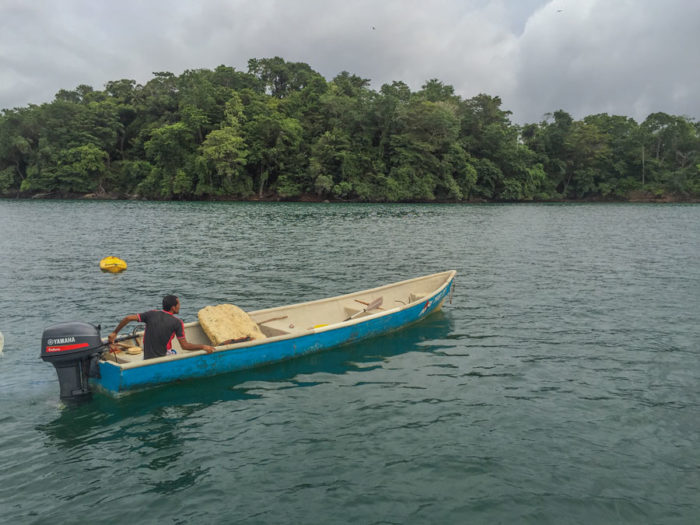
According to the International Monetary Fund, education is the number one driver that reduces income inequality. Carlos never went to high school, so it was with sincere pride that he stated that his daughter will at least have that opportunity.
Carlos may still be able to afford his family’s way of life as he diversifies his income—even if his daughter won’t follow him to sea. Possibly, the marine park and tourism can balance out the changes Carlos sees: drying land, warmer water, and eroding shores.
Mounting research shows that the hazards of climate change disproportionately hit poor and rural communities—those least responsible for creating it.1 The poor living on the coast have fewer resources—whether personal income, health care, or education—giving them fewer options to adapt. If Carlos can survive by means of the sea, it will have to be different from how he does it now. And he intuitively understands that.
Islas Secas
We’re anchored near a tiny beach that connects two islands at low tide. A small mountain of plastic trash mixed with driftwood covers the far side of this isthmus. I find plastic jugs, mint green fishing nets, bottles and a rainbow assortment of thousands of bottlecaps, childrens toys, twenty unmatched flipflops, nearly as many Croc-style shoes, and scores of single-use plastic bottles for shampoo, soap, or hand sanitizer. This is what Parida and Gamez must have looked like before the sustained effort to clean them.
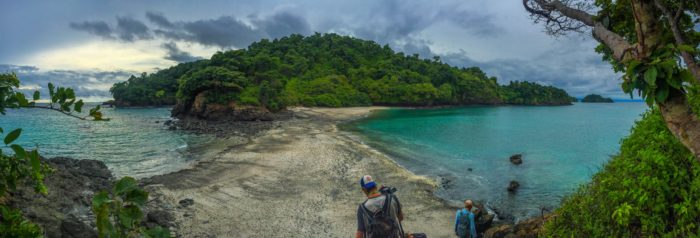
On the south side of the island, a boutique luxury resort peeks out from one of the bays, and at the recommendation of the friendly general contractor, who visits us one day by panga, we hike to find an enormous solar array next to the island’s paved airplane landing strip. The strip is so short that it requires a special plane that can stall out before it lands. Before the resort closed for a remodel, the cheapest room went for almost $700 per night. We anchor for free in the clearest water we’ve seen since the Sea of Cortez.
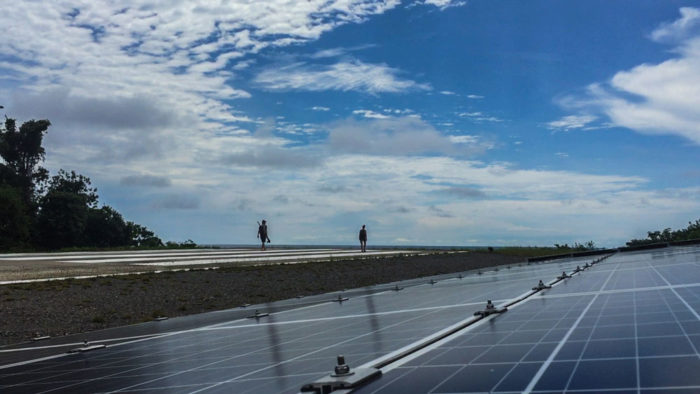
We meet no locals here. An occasional fishing panga anchors nearby to clean fish, sleep for a few hours, or use the shore as a toilet amidst the large sea grape trees clinging to the tiny sliver of land that disappears at high tide. We’re anchored with our friends Prism on this coast, together for safety and company in these remote places, amid unknown waters and the seemingly unending thunderstorm season.
The water is so clear here that we spend most of our time diving. We are rewarded with a spectrum of fish the likes of which we have not yet seen. Moorish idols dance in pairs, their dorsal fins streaming elegantly; butterflyfish light up the water in cheerful yellows; angelfish lead us around the corals; parrotfish larger than my torso parade the reefs in their brilliant greens and purples; the bicolor basslets flaunt their clashing purple heads with yellow tails; large indigo-colored angelfish hoover over the coral with fin tips flowing like silk chiffon. We hear and see whales everyday as they frolic in the protection of the shallow waters between islands. Large turtles nibble and rest in the corals. I had no idea that Panama would hold the most intact and diverse reef we have seen yet. We see one dive boat on the weekend, but otherwise the underwater world seems to live in the protective bubble of resort exclusivity.
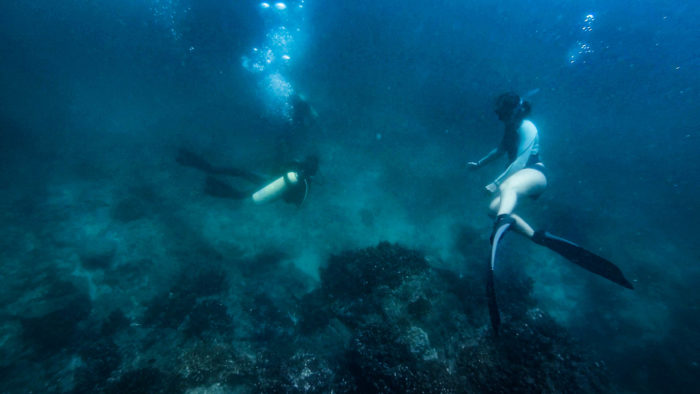
Eventually the weather drives us out of the anchorage as we search for calmer waters and better sleep. As we sail further south, we bypass Isla Coiba, the largest island in the Eastern Pacific. It’s a lauded national park, and park fees have recently made it prohibitively expensive to anchor there. In addition, every time we look to the island, ominous storm clouds hang overhead, making it less appealing.
I visited Coiba six years ago. While my friends surfed, I swam to shore with our guide and explored the plastic trash. My favorite find was a steering wheel. I dove this area as well, but it did not compare with what we saw at Islas Secas. I don’t know if this is the result of time and recovery, or if the reputed good fishing and diving of Coiba meant too much traffic.
At all of these islands, we are still very far from the nearest services. Over 20 miles of ocean and winding mangroves separate anyone out here from the world of health care and education. Aside from the likes of Carlos Bernal, these islands have mostly become the stomping (and diving) grounds for people with money, who get their medicine and education elsewhere. None of the local Panamanian kids in Davíd get to see the living, thriving reef we see. Meanwhile, single-use plastics wash out through the mangroves surrounding Pedregál and Davíd with each daily storm, covering these remote beaches. In a park, an ethic gets built to clean it; otherwise, it accumulates with the defecation of fishers on one end of an island as the elite imagine a pristine tropical paradise on the other end.
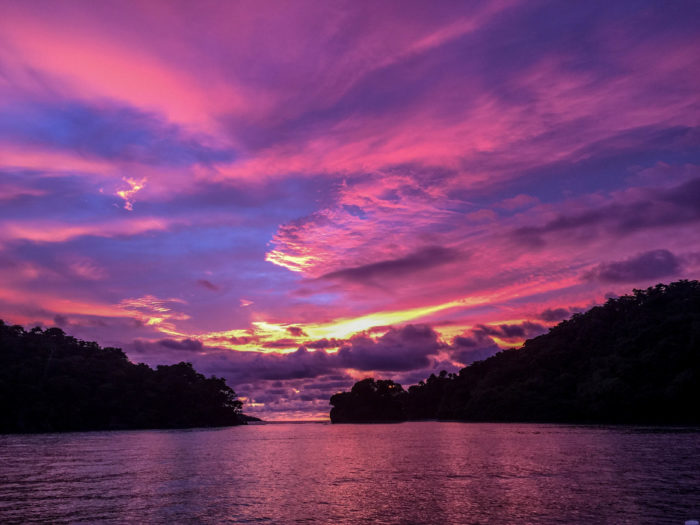
Bahia Honda
A few days later, we arrive to Bahía Honda on the mainland, but no closer to any services. Locals mostly live on a small island in the very protected and tranquil bay. It has been weeks since we have seen a car. All traffic in these remote areas travels by foot or cayuco, narrow canoes generally made from one tree.
We have also been weeks without cell service. As we arrive to the mainland, into the placid waters at the back of the bay, we still have no signal, and realize just how remote we still are. The physical land area of Panama is small, about the size of North Carolina, but mountains divide the coasts from the interior, leaving much of the coast rural and disconnected.

The bay is beautiful. The narrow entrance gives way to steep, sharp green ridges that seem to fiercely cradle the placid waters, holding the tiny island safe in the center. Narrow, low cayucos ply the waters, their pilots using handmade wooden paddles to slide through the water. Just like the dolphins that escorted us in, they follow the schools of fish leaping out of the water in dramatic flashes. The sound as the exit the water is like the amplified rush of 40 tap dancers landing on a stage at almost the same time.
As soon as we anchor, I retreat to our bed in the bow and fall asleep for a few hours—this coast has been as exhausting as it has been beautiful, thanks to strong currents, wild storms, and unprotected anchorages. This is the first flat water since Costa Rica. When we emerge into the brightness of midday, a cayuco pulls alongside. Ishmael has diesel, round papayas, and three types of bananas for sale. We buy one of his jugs of diesel (the other jug seems to have water mixed in,) and some of his fruit for what ends up being a bizarrely high price. He promises to return the next day, but we never see him again.
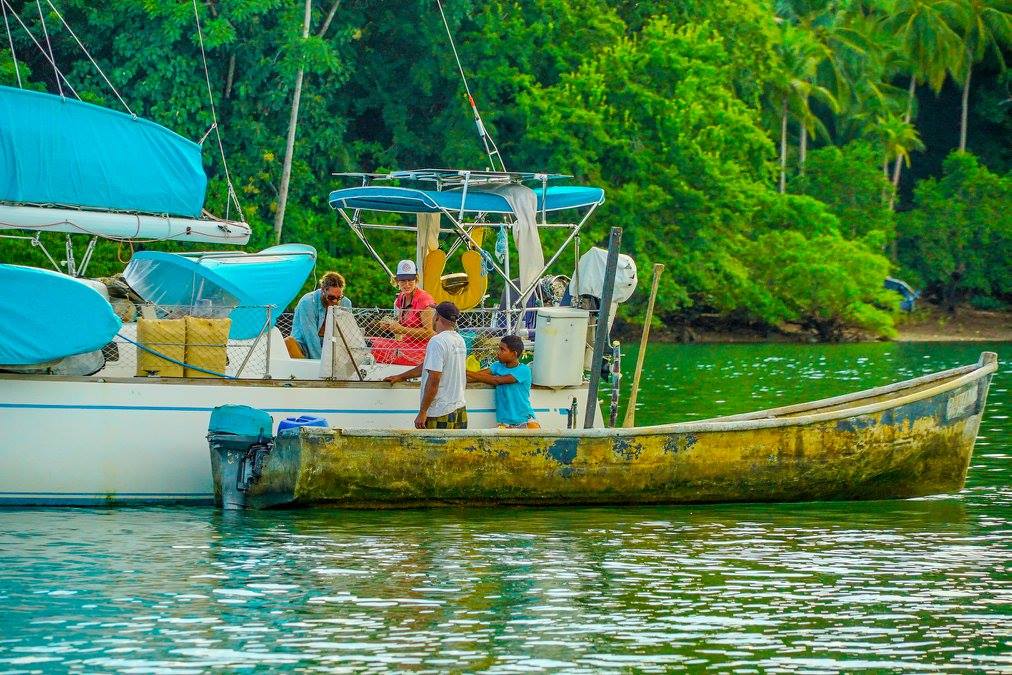
Our next visitors are kids in crude cayucos as slender as their hips. They sit only three inches above the waterline. Paddling to us, three boys sit stacked together in one impossibly narrow and low-slung boat. I chat with the bravest while the youngest boy silently bails water seeping into the canoe with a plastic yoghurt container. They want to know if we have books or magazines, and especially want a dictionary; we search our bookshelves, and the best I can find is a thesaurus. I give them all of our National Geographic magazines.
I ask why they aren’t in school, and they tell me they are on vacation. There’s a local primary school, but if they want a high school-level education, they have to find a way to live in Santiago, a city in the interior that is, at a minimum, a two-hour boat ride plus two-hour bus ride away. Only if they already have family living there can kids from this village get to high school. But brothers, aunts, and cousins will take them, even with the little room that they have.
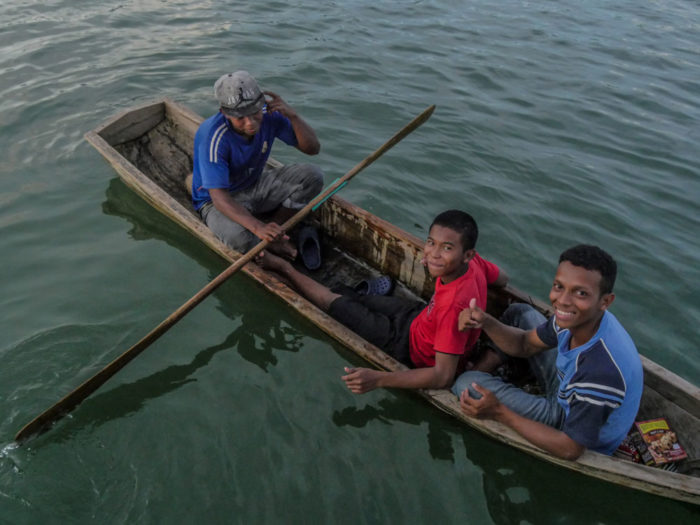
That night, we meet Kenedy, who arrives at our boat by panga. His father Domingo has developed a reputation among the sailing community as the local greeter, often in need of supplies from the outside world, especially batteries. Kenedy brings us bananas, coconuts, and a hardy local cilantro to trade for shirts, rope, and, of course, batteries. He promises to return the next day with his wife for dinner.
The next morning a very weathered-looking man pulls alongside our boat in a panga that looks nearly as old as him. This is Domingo, Kenedy’s father. His deep brown face folds into a huge smile when I ask if I can interview him about climate change. Like everyone else, he can tell me the seasons are shifting, and the rain falls harder and with new irregularity.
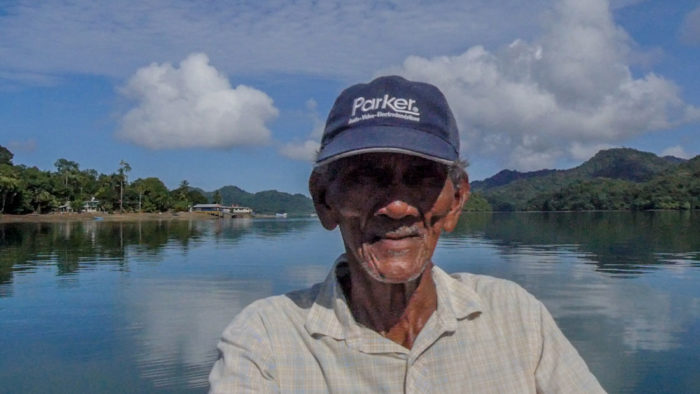
But he keeps steering the conversation to his village: they don’t want methods to combat climate change. They want health care. Any health care. He disparages the government in Panama City.
“We are community of four thousand! We should not be neglected. We need health care! We have no way to get medicine. There is no doctor here.” He’s almost shouting now, winding his slender frame up in his wiry muscles. After a lifetime of government promises for basic services, it’s enough to bring fire to this old man’s face. With his few teeth and decades-old pleadings for health care, he strikes me as embodying the wealth gap.
That night, despite a vicious storm building, Kenedy shows up at our boat, although he didn’t bring his wife out in the lightning. We give him dinner of spaghetti, which he eyes skeptically, (dinner is only rice and fish around here,) but he takes a second helping of cake for dessert. He tells me that almost all of the land surrounding Bahia Honda is owned by one wealthy America, who bought it up over time.
“Ishamel, who first visited you?” I think of the man who tried to sell us watery diesel and promised to return. Kenedy makes a sweeping gesture around the bay. “This was all his dad’s land. He sold it all, for almost nothing.” I can hear the disapproval in Kenedy’s voice, and can’t help but feel that this lines up with our experience of being overcharged by the son.
“He’s offered my father two million dollars for his land.” Kenedy pauses to scoop up more cake, and we can hear the wind start to howl as the thunder rumbles closer. “But he won’t sell. Two and half, he says. Only for two and a half.”
Two million dollars, never mind another half million, could bring quite a few more resources to this area. At that level, it seems like a silly number to quibble over. But from Kenedy, I can see that it’s not just about the land. It’s about pride, a solid kind of dignity that remembers the joy and safety of turning the land. His family has little in modern possessions, but what they have, they want to protect. Roots run through families and into the soil and salt water here—into a nearly disappeared way of life on the coast.
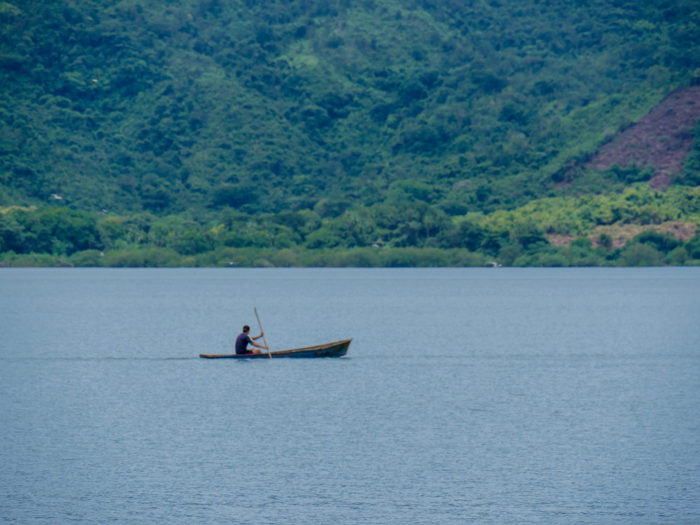
They don’t want to leave this area. They want to fish Isla Coiba and this bay just as they have for generations. In some ways, their remoteness protects them from development–but not from speculation or lack of basic services. They both know what they have, and what they are missing.
Panama City
We lace through a gauntlet of cargo ships anchored and waiting for their turn to transit the canal, chased to the head of the Gulf of Panama by the building storms. We must move quickly to avoid the whiteout conditions that accompany these storms, since the water is clogged with shipping behemoths, and it rains so hard it can render our radar useless. As we round the island that holds the canal’s “signal station,” the radio tower that functions as a sort of sea traffic control for the canal, the city rises like a mirage out of the water. Enormous thunderheads billow behind the skyscrapers, a reminder that it emerges from one of the most dense tropical forests in the world.
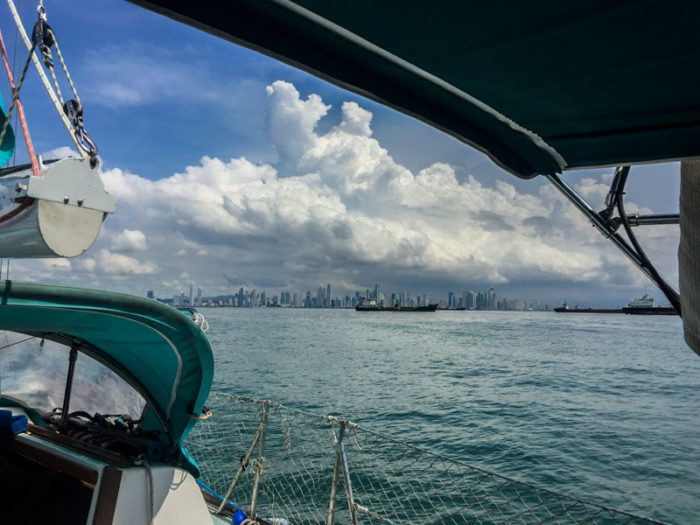
A hundred stories of reflective glass pierce the sky directly on the waterfront, hugging the shore and immediately reminiscent of Miami’s glitz. One building has an LCD screen broadcasting advertisements we can see from 10 miles away. Another building, with teal mirrored windows, somehow spirals like a soft serve ice cream. The shiny buildings are both glamorous and impartially mysterious, reflecting back the grays in the murky ocean water.
“Thirty years ago, my father used to swim at that beach,” my cab driver Luis tells me as we drive the new causeway around the famous fish market near the old colonial capital. “People used to come from outside the city to this beach: it was one of the prettiest in the world. Now, you can’t even get to the water. And it’s so polluted now, you wouldn’t want to.”
Even 10 years ago, there was still some beach left, he tells me. But the beach has been reclaimed for towering condos, the Trump Tower at the center. Downtown and tucked between the buildings, women with coiffed hair dyed blonde slip into the shopping malls that house boutiques from Cartier, Armani, and Gucci.
The cab winds off the causeway and into Casco Antiguo, the former capital center of Panama City that was sacked by Captain Morgan and his band of pirates in 1671. I still want to call it Casco Viejo, the name it went by only half a decade ago. But “viejo” has been changed to “antiguo,” a more elegant sound that hides the worn tones of “old.”
Although I was here only six years ago, I barely recognize it. The cobbled streets and stone buildings, reminiscent of Havana, were faded and in various states of crumbling decay before. Now, the narrow streets glisten with fresh paint and restored facades. Trendy cafés and bars complement the stone windows with modern glass. Restaurants beckon, from a cozy wood-fired pizza joint to an expansive, high-ceiling ballroom, whose street front is a series of large French doors that open to usher in the thunderstorm breezes. The restoration is dramatic enough to be breathtaking.
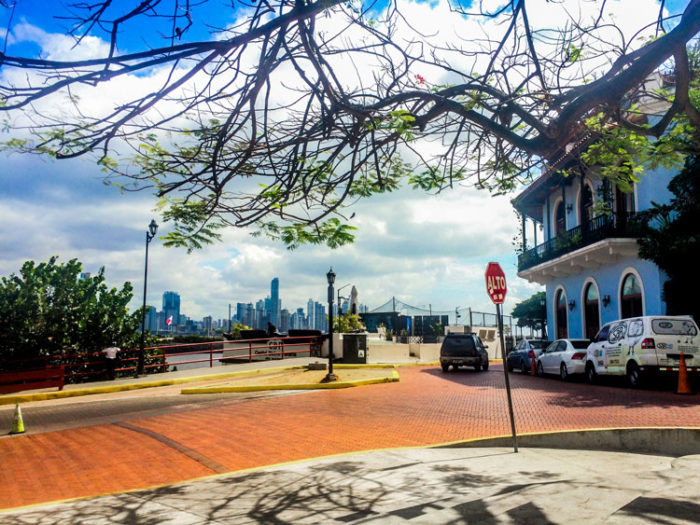
When I step into an Uber car to head back to the boat, my driver cuts to the edge of this district, and within a block the streets are crowded with children. The buildings seem to lean and glower into the street, no glass remaining in their dark eyes.
“This is El Chorrillo,” the driver tells me. For the restoration of Casco Viejo, most long-time residents were booted out of their homes to make way for the beautification. In this rapid gentrification, people were pushed to the edges of the neighborhood—which happens to be one of the most dangerous and crime-ridden barrios in the city.
This wealth dichotomy exists in many cities throughout the world, but in Panama City it all happens within sight of $270 billion floating past their drying laundry every year.
When we pass through the canal on our sailboat two weeks later, we have an “advisor” on board, a person who communicates with the canal and tells us where, when, and how to enter the locks. I asked him what it costs today for a container ship to pass through the canal. For our sailboat, the passage fee was $875.
First, he remarks that the rate had been increased at least six times since the canal was passed from the United States to Panama. Today, the toll is $72 per container. The largest ships carry up to 4,400 containers, so the bill can ring in over $300,000. To further this back-of-the-envelope calculation, 40 ships pass through the canal every day. Even if ships carries just half the maximum number of containers, that means that the canal grosses $2.3 billion per year (the general estimate turns out to be $2.5 billion.)
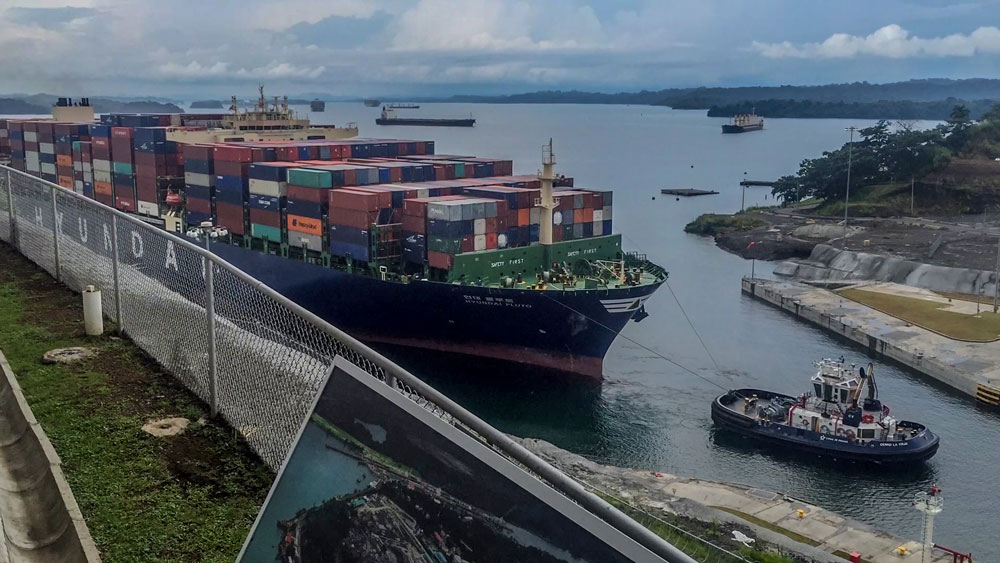
Even when factoring in the cost to maintain and run the canal, it seems possible that some of that money should go to finance education, that ticket to alleviating the wealth gap. Panama’s education is rated among the world’s worst, ranking 83rd of 144, which lines up with the fact that nearly 40 percent of the population live in poverty.
Unsurprisingly, the education divisions are wide between urban and rural areas. The rural communities on the coasts already have high levels of poverty and low political representation, never mind discrimination in Afro-Caribbean and indigenous populations, the majority of which live on the Caribbean shore. In addition, students are not trained to meet skilled labor demands, so Panama imports foreign workers in education, health care, and skilled labor sectors.
Driven by rumblings from economic analysts, who warned of a floundering national economy as the skills and education divide persisted, President Juan Carlos Varela expanded education infrastructure and reform when he took office in 2014. It remains to be seen if any of these benefit can make their way, first by road and then by boat, to the remote coastal villages.
The Pacific surf town of Santa Catalina now booms with tourists, crowded together at the one breaking wave. But when I traveled there eight years ago, the town had only just arrived on the radar. I showed up after pedaling my touring bike the 76 miles from Santiago, riding in the 100 degree heat all day unable to eat from food poisoning.
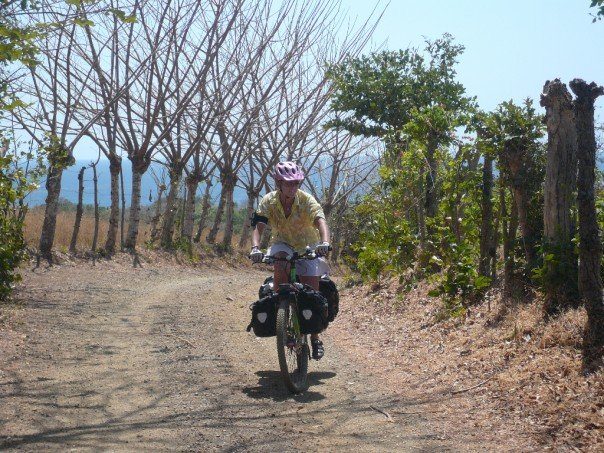
The town was quiet and tranquil, but not particularly friendly. When I rode out a dirt road, I found a man renting primitive thatch huts on a bluff overlooking the beach. When I asked about the gruff and jaded locals in town, he smiled.
“You see, this was a subsistence village here thirty years ago. People would fish or dive, then walk the trail to Hicaco, the closest town, and trade for rice or salt. Then do it all again the next day. But then that trail became a road, and now the road is paved. People didn’t even know how money worked: one man opened a gas station, but it shut down because he didn’t save any of his earned money to buy more fuel. He just spent it.” The locals that stayed suddenly had to pay to bus their children to school nearby, $2.50 each way every day. Many could not afford this and still eat.
When I ask in the islands about Santa Catalina, the Panamanians scoff, but sadly: they tell me that there are no more locals there. They all moved inland to Hicaco.
I think of this not-too-distant past when Domingo, the old man in Bahía Honda, talks about his life.
“Things used to be so much easier,” he laments. This surprises me: I would have thought that outboard engines, electricity, and cell phones would help people stay connected and not work as hard. But turns out it’s not about working hard.
“We had so much more then,” he tells me. “We grew so much, so we always had food.” He glances across the water at the steep, verdant ridges that shield Bahía Honda from the outside world.
“Times were simpler. We didn’t have medical care, but we didn’t need it: we were healthier.” It’s a classic grandfather’s lament. But as I look around the valley with this old man who has lived here for three quarters of a century, I can’t help but wonder if the world has its metrics wrong when it calls this man poor.
1. Field, C. B. et al. Climate Change 2014: Impacts, Adaptation, and Vulnerability. Part A: Global and Sectoral Aspects. Contribution of Working Group II to the Fifth Assessment Report of the Intergovernmental Panel on Climate Change. (Cambridge University Press, 2014).


